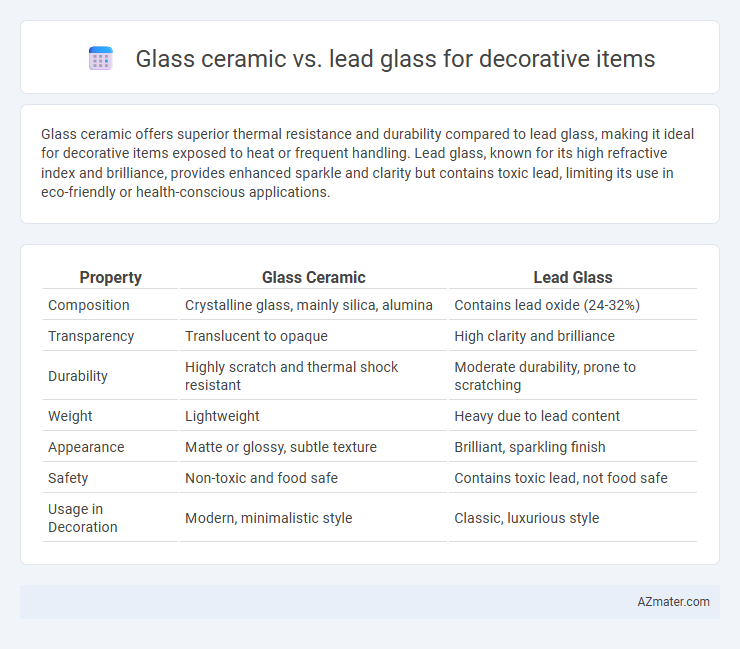Glass ceramic offers superior thermal resistance and durability compared to lead glass, making it ideal for decorative items exposed to heat or frequent handling. Lead glass, known for its high refractive index and brilliance, provides enhanced sparkle and clarity but contains toxic lead, limiting its use in eco-friendly or health-conscious applications.
Table of Comparison
| Property | Glass Ceramic | Lead Glass |
|---|---|---|
| Composition | Crystalline glass, mainly silica, alumina | Contains lead oxide (24-32%) |
| Transparency | Translucent to opaque | High clarity and brilliance |
| Durability | Highly scratch and thermal shock resistant | Moderate durability, prone to scratching |
| Weight | Lightweight | Heavy due to lead content |
| Appearance | Matte or glossy, subtle texture | Brilliant, sparkling finish |
| Safety | Non-toxic and food safe | Contains toxic lead, not food safe |
| Usage in Decoration | Modern, minimalistic style | Classic, luxurious style |
Introduction to Decorative Glass Materials
Glass ceramic offers superior thermal stability and durability compared to lead glass, making it ideal for decorative items exposed to heat or frequent handling. Lead glass, known for its high refractive index and brilliance, provides exceptional clarity and sparkle, enhancing the aesthetic appeal of decorative pieces. Both materials serve distinct purposes in decorative arts, with glass ceramic favored for functional decor and lead glass prized for ornamental brilliance.
Overview of Glass Ceramic
Glass ceramic offers superior durability and thermal resistance compared to lead glass, making it ideal for decorative items exposed to heat or frequent handling. Its microcrystalline structure provides a unique combination of transparency and strength, while lead glass is known primarily for high refractive index and brilliance. Glass ceramic is also environmentally safer due to the absence of toxic lead content, appealing to eco-conscious consumers in decorative markets.
Overview of Lead Glass
Lead glass, also known as lead crystal, features a high refractive index due to its lead oxide content, resulting in exceptional clarity and brilliance ideal for decorative items. It offers superior weight and brilliance compared to glass ceramic, enhancing the visual appeal of vases, chandeliers, and ornamental pieces. Though lead glass is softer and more fragile, its ability to be finely cut and polished makes it a preferred choice for intricate decorative designs.
Visual Appeal and Aesthetic Differences
Glass ceramic offers a unique matte finish with subtle translucency, providing a modern and sophisticated look ideal for minimalist decorative items. Lead glass, known for its high refractive index and clarity, delivers brilliant sparkle and depth, enhancing the visual richness and luxury appeal of decorative pieces. The aesthetic difference lies in glass ceramic's understated elegance versus lead glass's vibrant brilliance and intricate light reflections.
Durability and Resistance to Damage
Glass ceramic exhibits superior durability and resistance to thermal shock compared to lead glass, making it ideal for decorative items exposed to temperature fluctuations. Lead glass, while prized for its brilliance and clarity, is softer and more prone to scratching and chipping. The enhanced structural strength and resistance to impact of glass ceramic ensure longer-lasting decorative pieces with minimal damage over time.
Weight and Handling Considerations
Glass ceramic offers a lightweight alternative to lead glass, making it easier to handle and less strenuous for decorative items. Lead glass is denser and heavier, providing a solid feel but requiring more careful handling due to its weight. For intricate or large decorative pieces, glass ceramic reduces the risk of breakage and improves maneuverability during installation.
Safety and Toxicity Concerns
Glass ceramic offers superior safety over lead glass due to its non-toxic composition, eliminating risks of lead poisoning commonly associated with lead glass decorative items. Lead glass contains lead oxide, which can leach harmful substances, especially when exposed to acidic environments or when damaged, posing significant health hazards. Choosing glass ceramic for decorative purposes ensures minimal toxicity and safer interaction in household settings.
Customization and Design Flexibility
Glass ceramic offers superior customization and design flexibility for decorative items due to its ability to withstand high temperatures and undergo precise cutting, engraving, and shaping without compromising structural integrity. Lead glass, while prized for its clarity and brilliance, is less adaptable to complex custom designs because of its brittleness and lower thermal resistance. Designers favor glass ceramic when intricate, durable, and heat-resistant decorative pieces are required, whereas lead glass suits simpler, ornamental applications where visual sparkle is prioritized.
Cost Comparison and Market Availability
Glass ceramic offers higher durability and heat resistance but comes at a significantly higher cost compared to lead glass, making it less accessible for mass-market decorative items. Lead glass remains more affordable and widely available, maintaining strong demand in the decorative market due to its ease of production and attractive clarity. Market availability favors lead glass products, which dominate due to lower manufacturing costs and extensive supply chains.
Choosing the Best Material for Decorative Items
Glass ceramic offers superior thermal resistance, durability, and scratch resistance, making it ideal for long-lasting decorative items exposed to temperature variations. Lead glass provides exceptional clarity and brilliance, enhancing the aesthetic appeal of decorative objects with its high refractive index and weight. Choosing between glass ceramic and lead glass depends on whether the priority lies in durability and heat resistance or in optical beauty and sparkle.

Infographic: Glass ceramic vs Lead glass for Decorative item
 azmater.com
azmater.com